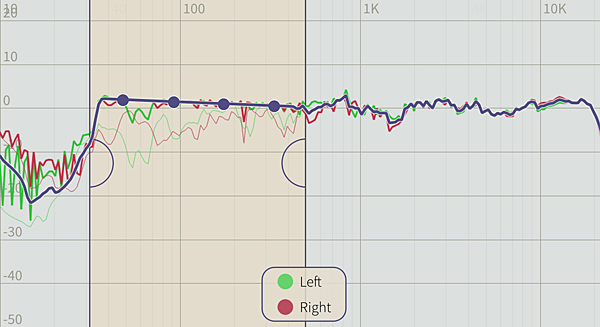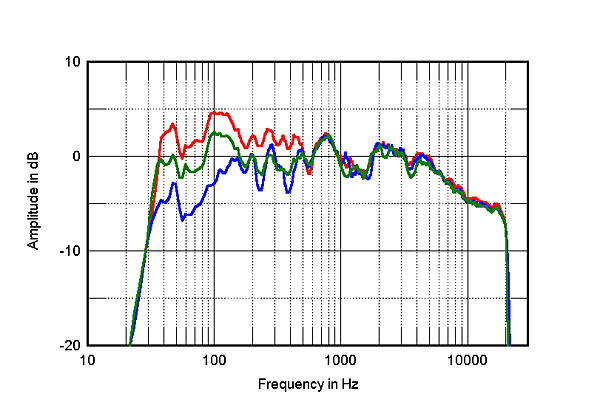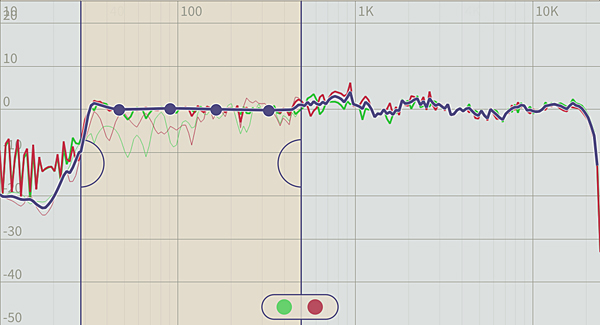| Columns Retired Columns & Blogs |
Another nominee for Stereophile 2020 product of the year award, NAD M10 :-) ........
To use Dirac Live LE with the M10, I plugged the microphone supplied with the amplifier into the 3.5mm jack on the USB adaptor, also supplied, and plugged that into the USB Type A port on the M10's rear panel. I installed the Dirac Live app on my iPad mini, after first making sure that it and the M10 were connected to the same network. When I ran the app with the M10 driving my KEF LS50s, it found and identified the amplifier, reduced the playback volume, and performed a level check. I then followed the on-screen instructions, placing the microphone in each of the nine positions specified by the app and performing a "chirp" test at each. After the last test, Dirac calculated a correction filter and asked for it to be named and saved to the M10's internal DSP. Imaginative as always, I called the correction filter "LS50."
When I then ran the BluOS app on the iPad, the Audio Settings menu now included an on/off switch for "LS50." The target response for the filter is shown as the dark blue trace in fig.1 and can be compared with the before and after responses for each speaker (respectively thin and bold green and red traces).

I was listening to J.S. Bach's "Wachet Auf," from a favorite album, Yo-Yo Ma and the Amsterdam Baroque Orchestra's Simply Baroque II (16/44.1 ALAC files ripped from CD, Sony Classical 60681) when, using the BluOS app, I turned on the low-frequency correction Dirac had calculated for the KEF LS50s. The low frequencies became richer and the orchestral sound acquired greater bloom. This was definitely a step in the right direction.
I continued listening to recordings I knew well, both classical and rock. Well-recorded classical piano fared particularly well with the small KEFs corrected by the M10's Dirac Live. The weight added to the left-hand register of Evelina Vorontsova's instrument on her hauntingly beautiful reading of Rachmaninoff's second Piano Sonata (16/44.1 ALAC file ripped from CD, STH Quality Classics CD 1416092) was addictive. And that weight was not accompanied by any blurring or boom. However, when I listened to the Simon Rattle Beethoven symphony I had used for my comparisons with the Luxman amplifier, I couldn't escape the impression that there was too much upper bass with the Dirac EQ.
Accordingly, I measured the LS50s' spatially averaged in-room response with the speakers driven by the NAD M10 with and without the Dirac-calculated correction. (I used the same methodology I have been using for 30 years—averaging 20 spectra, taken for the left and right speakers individually using a 96kHz sample rate, in a vertical rectangular grid 36" wide by 18" high and centered on the positions of my ears. The only change from past practice was to show 1/12 octave–smoothed spectra rather than 1/6 octave, in order to reveal more detail.)
The results are shown in fig.2. (Ignore for now the green trace.) The blue trace is the in-room response of the uncorrected speakers. It slopes down below 200Hz and above 2kHz. The former is due to the fact that the speakers are positioned well away from the room's sidewalls and front wall and don't, therefore, benefit from any low-frequency boundary reinforcement. The latter is due to the room's increasing absorption at high frequencies—the KEF's highs actually sound neutrally balanced at the listening position.

The red trace in fig.2 shows the LS50s' spatially averaged in-room response with Dirac Live correction applied between 50Hz and 500Hz. You can see that the corrective filter calculated by Dirac has flattened the balance in the lower midrange but has overcompensated for the KEFs' shelved-down low frequencies. There is now an apparent excess of energy of 2–5dB from 40Hz to 150Hz, correlating nicely with my perception. Note that the measured responses roll off rapidly above 20kHz. This is due to my feeding the diagnostic test signal to the M10's analog inputs, which digitize it with a 44.1kHz sample rate. Repeating a response measurement with digital data sampled at 96kHz and 192kHz fed to the M10's coaxial S/PDIF input indicated that the Dirac filter did function identically at the higher sample rates.
Though both are centered on the position of my head in my chair, the grid spacing and layout I use for my traditional measurements and those used by Dirac Live are slightly different. (This shouldn't make a big difference because once the number of positions where the responses are measured reaches nine, the spatially averaged response converges on a consistent result.) I also use a high-end Earthworks omnidirectional microphone for my measurements, though I doubt that would account for the differences between the red and blue traces in fig.2. Nevertheless, I plugged the NAD mike and USB adaptor into my laptop, where it was identi fied as "NAD USB Audio" and could be set to sample rates of 44.1kHz or 48kHz with a bit depth of 16. I did some tests comparing the NAD mike with my Earthworks mike, and the two had identical responses below 1kHz.
More experimentation was necessary. I turned off the original LS50 filter and ran the Dirac Live app again. However, this time, when I had finished the measurements and the app had calculated the correction filter, instead of accepting what I was shown, I used the Control buttons—the solid circles superimposed on the target trace in fig.1—to reduce the intended levels below 200Hz by 2dB or so (fig.3).

The new spatially averaged room response is shown as the green curve in fig.2. Now when I listened to the Simon Rattle Beethoven recording, the mid- and upper-bass regions were in better balance with the midrange. And there were sufficient lows for the Rachmaninoff piano sonata recording still to sound magnificent. The subtle organ bass pedal line in the "Kyrie Eleison" from the sublime Robert Shaw/Atlanta Symphony Orchestra recording of the Duruflé Requiem (16/44.1 ALAC file ripped from CD, Telarc CD-80135) was more evenly balanced with the Dirac EQ than it was without. The extra bass energy didn't seem to stress the KEFs, and though I haven't shown them, the responses for the left and right speakers at the positions of my ears now matched very closely below 500Hz.
To sum up, NAD's incorporation of Dirac Live in the M10 is a huge added value, especially if you have a small-to-medium–sized room and minimonitors that you like or need to place a ways away from the room boundaries. As much as I love the unequalized LS50s, their presentation corrected with Dirac Live was addictive.—John Atkinson

Another nominee for Stereophile 2020 product of the year award, NAD M10 :-) ........

'Thin Red Line' and 'Bold Red Line' :-) .........

The Transistor was the most important invention of our last Century, wasn't it?
This high-achieving little box seems like a dam nice 1980 Era Hifi extrapolated out into our new 21st Century needs. ( I haven't yet had the chance to ask my Michigan NAD Critic if this box is serviceable or if it's another unserviceable throwaway, as so many electronics from Asia seem to be nowadays ).
As I started reading this review I'd thought that the device was the size of a BIG Mono Amplifier. Of course, it isn't at all "Large" unless it's compared to an iPhone or a Dragonfly .
Its amazing that a little device like this could be sooooooo dam powerful. Phew, seems like a parade motorscooter the Shriners ride but with 3,000 horsepowers.
Yet as powerfully potent as this NAD is, only a few pages away is a descriptive comparison of two low power amps serenading our HR into blissful oblivion.
Ultra high performing 21st Century Transistors vs. low power Valves ? Can I have both?, pleeeeeezzzzeeee
Tony in Venice ( all over Primary country & Counties )
ps. as much as I've abandoned ( and discourage ) vinyl hoarding, Mr. Dudley's writings are delightful ( especially the Naim Quad descriptions )
ps. thank you for the delightful read whilst out on the lonely trail.

... eat it too? Absolutely.
Just connect the pre-amp outputs of the NAD M10 to the inputs of a Luxman MQ-300 8W triode tube power amp.
http://www.luxman.com/product/detail.php?id=17

Are you spending any time in 'wine caves' and drinking from '$900 a bottle wines', Mr.Tony? :-) ........

I'm in plenty of Plane Hangers, all without booze.
I don't see the money collecting, ever.
I'm involved with the nuts & bolts of keeping the Big Show on the Road, in the Air and not missing dates or scheduling.
This is an unsettling lifestyle that some people thrive in, I'm not one of em. It's a Carnival like Ringling Brothers, we are anticipating a three fold increase in busyness & activity. Bernie's nomination will make everything we know seem tame. ( we're told )
I might be too old to keep up.
Fingers Crossed
Tony in Venice ( for a breather )

... running to catch a train, as does the 70-year-old Sen. Warren.
https://www.youtube.com/watch?v=FKHbJEAs2D4

Thanks for the advice.
I've just ordered a used "Royal Canadian Air Force Exercise Manual" from eBay and promise to begin my Training Program as 2020 rolls out. Exercises include Running which will probably be the hardest part of the 5BX group considering that I'm too outa shape to be exercising.
Lovely News:
I've been on a Cancer Alert since early 2017 and just went Clear by my latest Radiologist Reporting from Nov. Phew !!!
I'm no longer living in fear.
I have no health issues: A miracle considering how I've smoked 15,000 packs of Cigs.( lifetime ) and guzzled 5,000 fifths of Hard. ( from 1985 to 2000 )
I'm feeling lucky
Tony in Venice
ps. I'm still on Oakwood Cemetery's rather long waiting list

Mr. TonyKaz: the best comment you have made in a long time. Don't pay too much attention to us doctors, just open your eyes (and your ears!) Daily and marvel at the magic that surrounds you. God bless you, Merry Christmas!

... just get a decent pair of shoes and go for a walk.
Three to four miles per day is a good target.
The 5BX plan is an excellent strategy, too.
https://csclub.uwaterloo.ca/~rfburger/5bx-plan.pdf

Are there any 70-year-olds here at Stereophile, who can run and catch trains? ....... I wonder? :-) .......

...run faster than a train. It wasn't speeding, it was in fact nearly stopped, but still, John was running at a good clip.
Happy Holidays to everyone. And glad to hear you're healthy as a horse, Tony.
Peace and love,
Rob S.

John Atkinson is actually Superman ....... You missed to see that cape? ....... Happy Holidays :-) .......

Thank you for writing, nice to hear from y'all.
We have a smallish group ( in Venice Fl. ) of Octogenarians running the Waterfront/Inter-coastal Trail, it's impressive seeing what Id've thought was impossible ( and is in the Frozen North ). I might be joining them. Flying back to Sarasota is like returning to Paradise, moving here is proving to be a dam good decision.
Hmm, JA on running in NY, I wonder.
JA on running Stereophile: retired JA seems to be doing ever more beautiful writing as are a number of regular contributors. These guys are raising their Game, that Naim/Quad story rivals the best writings. Editorial content is consistently deep, philosophies are revealed, wisdoms are being explained. 5,000 well thought-out word review/stories in abundance. Audiophile or not, Stereophile rivals any Mag. on the Stands for intelligence, it's one of the best kept secrets in Publications. ( the ones I travel with get worn out by multiple readers )
Now, I hope & wish that Tyll would return to Print from the High Planes of New Mexico. ( Bob Katz, too )
Tony in Venice

Run, run away fast.

I've used NAD products for about 20 years, starting with an 80-watt integrated, then moving up to their pre- and power amp combo and CD player, and finally to their wonderful M51 DAC. Unfortunately -- based on Mr. Atkinson's recommendations -- I also bought their M32 "direct digital" amplifier and their M50.2 server. My experience is that their older equipment not only sounds better, but is MORE DEPENDABLE than their new stuff.
After using it for a couple of months, with its hard drive only half full, my NAD M50.2 now simply refuses to rip any new CDs. After listening to the M32 for several months, I've now gone back to the M51 DAC and NAD power amp combination. The M32 had an irritating forwardness in the upper midrange that became unpleasant over time, whereas their earlier DAC and analog power amp sound much better.
Mr. Atkinson, how long did you actually live with these products? I frankly am having trouble trusting your reviews of them.

Mr. Atkinson, how long did you actually live with these products? I frankly am having trouble trusting your reviews of them.
I'm sorry to hear about the problems you had with the M50.2 and M32. Reviewers tend to live with a product for 4-6 weeks, so longer-term reliability is not something that can be examined in a review. In the case of the NAD M10, though I used it in my system for most of September and October before writing the review, I subsequently purchased the review sample. Putting my money where my mouth is, if you like. I will report if I have any issues.
John Atkinson
Technical Editor, Stereophile

Thank you for your reply. I was concerned not just with reliability but sound quality. Does the M10 sound better than the M32? I found the much cheaper combination of the M51 DAC and the old NAD C272 power amp to sound definitely better than the M32.

What loudspeakers are you using? ...... As you know loudspeakers make a big difference in sound quality :-) ........

Thanks for your sage advice. I've used several different speakers with the NAD M32 and the NAD M51-C272 combination. They include the Dynaudio Special 40 (nice, but an unpleasant upper midrange emphasis, at least in the nearfield where I listen). Aerial 5T (awful: upper bass bump, too little midbass, dry sound overall). Tekton Design Uruz (a pretty good low cost, essentially DIY design; excellent highs). And the Buchardt Audio S300 MkII: Better than the Dynaudio overall, with a more pleasing and relaxed balance and deeper bass. My current speaker for nearfield listening, which is almost always how I listen.
In my judgment the NAD M32 doesn't sound completely natural in the upper mids and highs, and easily becomes fatiguing and even irritating. I notice John Atkinson didn't "put his money where his mouth is" despite saying it was "highly recommended."

May be you could listen to/with KEF LS-50 and/or, may be Polk L-100 (which were favorably mentioned by RS in a recent dealer demo) ........ Both the KEF and Polk speakers are in the same price range :-) .......

The problem is not the speakers, despite your insistence. (I am curious about the new Polks though--the L200 more than the L100.) I'm actually quite happy with the NAD M51 / C272 / Buchardt Audio combination and plan to sell the M32 if I can. It just doesn't measure up--works OK for rock, pop, or electronic but not for classical. I'm especially pleased that the Buchardt's give me such a deep soundstage even though I listen in the nearfield and with the speakers close to the wall. And they are great all-rounders too. I hope Buchardt keeps developing new products.

May be you could try a tube integrated amp, like the Rogue Audio Cronus Magnum III, $2,995, for example :-) ......

... reading what I wrote.

HR liked the sound of Dynaudio Contour 20 with PrimaLuna tube amp, for example :-) ........

... near-field listening, have a listen to any of various models from Harbeth.

Glad you still have the NAD M10, with you JA1 .......... May be you could review the new Polk L-100 bookshelf/stand-mount speakers ($1,200/pair), which were favorably mentioned by RS in a recent dealer demo ....... L-100s are in the same price range as the KEF LS-50 :-) ........

If the NAD M32's "direct digital" system is so great, and you thought it was "highly recommended," then why did NAD go back to using the ESS Sabre/Hypex module approach here? Maybe direct digital doesn't sound so great after all?

JA1 could also review the new NAD M33, due for release in January 2020 ($4,999) ......... 200 WPC and has Purifi's 'Ultra-Quiet Amplification Technology' :-) .......

So, I've carefully followed NAD amp development.
I don't believe "hybrid" here refers to taking in both an analog and digital input. As far as I know, in the NAD product lineup the 3020D was among the earliest. As I recall, it is a hybrid because it runs a small, linear class A amp in between two Class D voltage rails. It's closer in topology to the Carver/Yamaha EEEngine type of designs. It may be designed with Hypex, but it is not a straight forward nCore either.
One of the dead giveaways is the idle power. It runs unusually hot for a pure class D.
Also, switching is not Class D, but if you are going to do A/D, then room correct, well, you wouldn't be wrong in calling it a digital amp anymore.
I comment on all of this because I am curious, not because I am sure, so if the good peeps at Stereophile can confirm or correct, that would be nice.
Best,
Erik

If you want to use a headphone amp connected to the pre out, what do you need to do to stop the speakers from getting amplification.

Anyone have any experiences upgrading the stock power cord? What about adding a power conditioner?